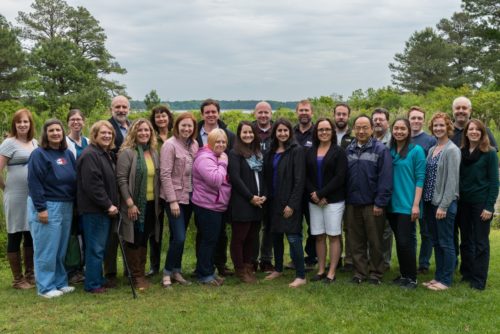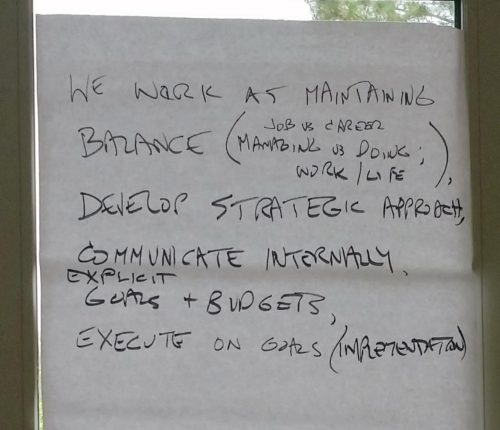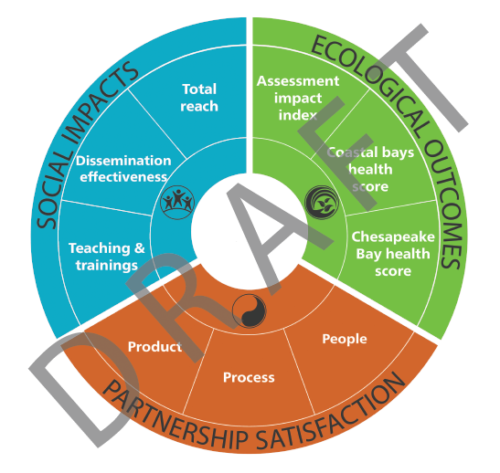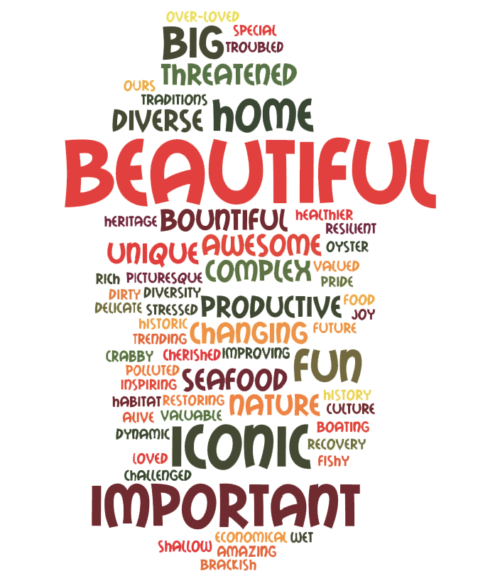Annual retreat fuels new thinking and cross-pollination of ideas
Caroline Donovan ·What is the definition of retreat? We all immediately think of military retreats in battle. But, there are two other definitions of retreat that relate to our annual work retreat:
- a quiet or secluded place in which one can rest and relax - this is what most people intend when they go on a retreat or retreat to a vacation spot. Work retreats can be restful and relaxing because they bring you out of your day-to-day work space and provide a new creative arena to focus on.
- an act of changing one's decisions, plans, or attitude, especially as a result of criticism from others – this definition is even more appropriate for our annual work retreat, where we are asked to evaluate and assess our own accomplishments, objectives, and weaknesses.

Our annual retreat is held in the spring of each year and we invite not only the smaller, core group of UMCES staff that sit at our partners’ offices (U.S. EPA’s Chesapeakeay Program and Maryland Departments of Natural Resources and the Environment). This provides a cross-pollination of ideas and broader thinking to help IAN be even more successful in the future.

This year’s retreat consisted of several key activities that will help IAN become a better organization – the ABT phrase exercise, the Snap exercise, and the IAN report card project.
ABT – And, But, Therefore
The point of this exercise is to deliberately think about a narrative that tells your story in a few short sentences. IAN has adopted the ABT model and has already written We have great people doing impactful things AND we’re flexible, BUT we lack effective internal communication and [have] too much work with competing priorities; THEREFORE, we work at maintaining balance, developing a strategic approach, communicating internally, executing on goals (implementation), and bridging disconnects.

Snap exercise
The point of this exercise is to see how many people come up with the same concept, which shows the priorities of your staff. For the IAN retreat, we wanted to determine what the staff thinks as the key values of IAN and the key threats to IAN’s success. Everyone writes three values and three threats onto sticky notes and calls out ‘Snap!’ when someone else says the same values and threats as their own.

IAN report card project
The point of this project is to evaluate IAN’s success using the same 5-step process that we use for our ecosystem health report cards around the world. The initial report card workshop was held in February of this year. We are applying the following steps: Conceptualize the system (in this case, IAN), Identify indicators, Determine thresholds, Calculate Scores, and Communicate via a report card. We are currently in the process of determining which indicators are the best to represent IAN and the thresholds against which we would compare ourselves. Preliminary topics include Social Impacts, such as dissemination effectiveness and reach; Ecological outcomes, such as improved health of ecosystems we evaluate; and, Partnership Satisfaction, such as how IAN has influenced our partners and their goals and objectives. The expectation is to have the draft IAN report card available in late fall 2016.

While the retreat was only one day, we managed to cram in quite a bit of work, fun, and socializing. In addition to these exercises, we shared personal photos and favorite songs, ate a picnic lunch together, and caught up with colleagues that we don’t get to see on a regular basis. We were all asked to describe the Chesapeake Bay in three words and a word cloud of the results was created. The most popular words were Beautiful, Important, Iconic, and Fun. I think these words also describe working at IAN and we can continue to do important work and have fun if we make sure to spend time at our annual retreat each year.

About the author
Caroline Donovan

Ms. Caroline Donovan oversees program and project management, science communication, and data analysis at UMCES-IAN. She has over 15 years of experience with ecosystem health report cards, science communication products, stakeholder engagement, and citizen science and volunteer monitoring. Ms. Donovan has worked extensively in the fields of science integration and communication, facilitation, and program management and administration. Ms. Donovan received a Bachelor of Science in Biology from University of North Carolina - Wilmington in 2002 and a Master of Science in Biological Oceanography from University of Maryland - College Park in 2005.
Next Post > A pleasant day of Oysters and STEM learning
Comments
-
Atika 4 months ago
Thank you for sharing this great information with us, i really appreciate your post!